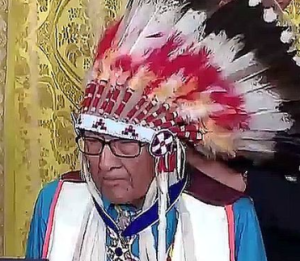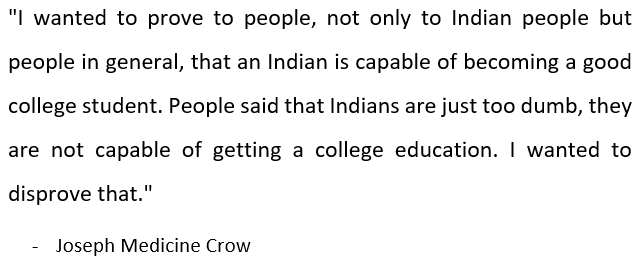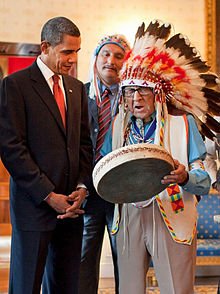Joe Medicine Crow: Biography, Accomplishments and Other Notable Facts
In April 2016, decorated World War II veteran, Joe Medicine Crow passed away, making him the last war chief of the Indigenous Crow Nation. Apart from serving in the war, Crow attained more popularity for his writings on Native American history.

Known as the last war chief of the Crow Nation, Joe Medicine Crow distinguished himself valiantly in World War II (WWII)
Early Life & Education
Crow was born in Lodge Grass, Montana to parents Amy Yellowtail and Leo Medicine Crow. The family lived on the Crow Indian Reservation, and his father was a war chief. On his mother’s side, he was the nephew of White Man Runs, a brave soldier who had served as a scout for the US General George Armstrong Custer. White Man Runs also experienced the 1876 Battle of the Little Bighorn firsthand.
Growing up, Crow learned how to ride horses, hunt, and withstand below-freezing weather conditions. Life on the reservation wasn’t easy. The Crow tribe at the time had less than 2100 members after years of being plagued by starvation and disease. Many members of his family had to steal cattle in order to survive.
Crow decided to attend school, believing it was the only way to save his tribe and heritage from being wiped out. In 1929, he enrolled at Bacone College, becoming the first person to attend college from his tribe. He learned that the tribe’s greatest warriors had accomplished four major feats to become war chief: touching an enemy while alive, wresting an enemy’s weapon away from them, stealing an enemy’s horse, and leading a successful war party.
He later went to Linfield College to pursue a bachelor’s degree in sociology and psychology. In 1939, he completed his masters in anthropology from the University of Southern California.
Medicine Crow worked briefly at a Native American School. Before enlisting in the US Army, Crow had been working towards obtaining a PhD. He never completed it.

Joe Medicine Crow (1913-2016): Biography, Accomplishments and Other Notable Facts
Time in the Army
Medicine Crow joined the army in 1943 and became a scout for the 103rd Infantry Division. During the Second World War, he was known for wearing war paint underneath his army uniform, as well as a yellow painted eagle feather under his helmet. He believed that those paintings and feather would protect him from harm.
While fighting, he met the requirements for becoming a war chief in his tribe. He touched an enemy and disarmed another. Medicine Crow also stole several horses and led a successful war party. He also bravely led his squad through dangerous land mines while avoiding enemy fire. In addition to leading a raid, he was part of a number of missions that went deep into enemy territory to procure vital ammunition.
Upon his return to the United States, he was declared war chief by his tribe after he recounted his time in the war. According to the tribe’s elders, he had fulfilled all requirements to become a war chief.
Read More: Timeline of Major Events during World War II
Did you know?
Joseph Medicine Crow was not just the last war chief of the Crow Nation, but he was also the last war chief of the Plains Indian.
Growing up, he went through several difficult training exercises, including running barefoot through below-zero temperature in an attempt to strengthen his feet. His elders also made him bath in freezing lakes to enhance his inner core and spirit.
Accomplishments

Former U.S. President Barack Obama and Crow Nation war chief Joe Medicine Crow, in 2009
Below are a few more achievements chalked by Medicine Crow:
- He was the recipient of both the Bronze Star Medal and Légion d’honneur in 2008 for his exceptional service while serving in the army during the Second World War. He received other military awards such as the Combat Infantryman Badge, World War II Victory Medal and the American Campaign Medal. In 2009, he received the Presidential Medal of Freedom from then-U.S. President Barack Obama.
- Following his return from war, Crow worked at the Crow Agency and was made historian and anthropologist in 1948. He also served on the board of the Crow Central Education Commission and was one of the founding members of the Traditional Circle of Indian Elders and Youth. The Native American war chief also co-founded Little Bighorn College and the Buffalo Bill Historical Center. Medicine Crow spoke at various conferences and universities and at a United Nations summit in 1999.
- Crow preserved many of his tribe’s stories through his books, most famous among them “Crow Migration Story”, “Medicine Crow”, “Crow Indian Buffalo Jump Techniques”, “Handbook of the Crow Indians Law and Treaties”, and “From the Heart of Crow Country.” He was also a children’s book writer, penning works such as “Brave Wolf and the Thunderbird.” In 1965, he wrote the script for the reenactment of the Battle of Little Bighorn.
- The famous WWII veteran received honorary doctorates from Rocky Mountain College, the University of Southern California, and Bacone College.
Death
In his later years, Crow frequently lectured at a numerous institutions. He died in 2016 at the age of 102 and was survived by his son, Ron and three daughters, Vernelle, Diane, and Garnet.

In 2009, U.S. President Barack Obama presented the Presidential Medal of Freedom to Joseph Medicine Crow. The medal is the highest civilian honor in our nation.
























